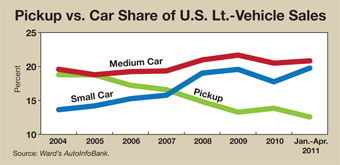
Americans’ love of pickup trucks, the lifeblood of Detroit auto makers and once the darling of U.S. consumers, marked a 31-year low in April.
Against a backdrop of sluggish housing starts, high unemployment and skyrocketing pump prices – key historical barometers for the segment – fullsize and small pickups accounted for 11.8% of total light-vehicle deliveries in the month
It is the segment’s lowest market share in the Ward’s database, which dates back to 1980. At their peak in July 2005, pickups accounted for 22.9% of U.S. LV sales.
The share shortfall occurs as sales climb. Through the first four months of 2011, pickup deliveries were tracking 17.9% ahead of like-2010. However, total U.S. light-vehicle sales were pacing 19.4% ahead of prior-year, according to Ward’s.
Related document: Ward’s U.S. Light Vehicle Sales by Segmentation
The downturn for pickups is the latest notable shift in U.S. consumer preference, which has seen light-truck demand dwindle in favor of cars. Light trucks outsold cars in 2010, but through April their lead slipped to a slim 5,000-unit advantage.
“In Texas, the biggest truck market in the U.S., our volume typically was 50% F-Series sales,” says Randall Reed, owner of five Ford dealerships in the Lone Star State.
“But that has come down since the Fiesta and the Fusion,” Reed tells Ward’s, referring to the launches of the Blue Oval’s B-segment and midsize-car entries.

Factor in the new-for-’12 Focus C-car, and “we’re going to balance out and be selling more cars than ever in our history,” he adds.
Historically, pickup share has run second to the Middle Car segment, as defined by Ward’s. In 1980, pickups accounted for 14.7% of the U.S. light-vehicle market, while the Middle Car segment commanded nearly three times that amount, or 39.8%.
By 2005, the two segments were running bumper-to-bumper, with pickups controlling 18.77% of the market compared with the Middle Car segment’s 18.79%.
Through April, pickups accounted for 12.6% of U.S. light-vehicle sales, while the Middle Car segment made up a whopping 20.8%.
Pickup demand generally runs parallel to employment rates and gasoline prices. During the heady days of 2005, unemployment was 5.0% and a gallon of regular unleaded cost $2.28, according to the American Automobile Assn.
These factors contributed to the development of a healthy “personal-use” pickup market. But these buyers largely have disappeared in the wake of today’s 9% jobless rate and 138 consecutive days of $3-plus prices for regular-grade gas nationwide.

Housing starts, a well-established barometer of pickup popularity, totaled 549,000 in March, the latest available count from the U.S. Dept. of Commerce. In July 2005, that number was 2.1 million.
In an ironic twist, the segment may experience a slight uptick from rebuilding efforts in several southern states that were devastated last month by a rash of tornadoes, according to George Pipas, Ford’s top U.S. sales analyst.
“Those kinds of things tend to create economic activity in the aftermath,” he tells Ward’s in a recent interview.
And Pipas says commercial demand for pickups is on the upswing, as F-Series sales last month rose 3.7% to 42,723.
GM has similar high hopes for the segment. Don Johnson, GM's chief sales analyst, says pent-up demand following the recession should boost sales going forward.
Demand is expected to come from the small-business sector, where a “solid recovery continues,” he says. “Our sales to these companies are up 23% and, of this volume, more than 70% is to businesses involved in agriculture and construction.”
Deliveries last month of GM’s top-selling pickup, the Chevrolet Silverado, fell 4.6% vs. year-ago to 29,342, while GMC Sierra sales were 10,523, an 8.3% year-over-year increase.
Fullsize pickup models are the volume flagships of each Detroit auto maker: the F-Series at Ford, Silverado at GM and the Ram at Chrysler.
– with James M. Amend

